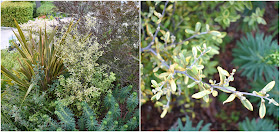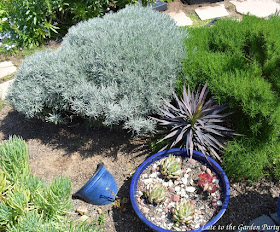Chloris of
The Blooming Garden posts a monthly top 10 list of what's flowering in her garden and invites others to join in. I don't routinely participate as what I'd cover would frequently be a rehash of what's covered in my mid-month Bloom Day post. As my March 15th Bloom Day post was particularly extensive, bordering on obnoxious, another post featuring many of the same blooms might strike readers as overkill. Hopefully, Chloris will forgive me if I put my own spin on her meme. The focus of this post will be on my favorites among the newest blooms in my garden. With a few exceptions, these are flowers that didn't start blooming until the second half of the month. In Spring, when almost every day reveals a new jewel, it isn't all that hard to come up with 10 candidates. In fact, I had several that I culled from the list for the purposes of this post.
In my mid-month Bloom Day post, I bemoaned the fact that some of my most flamboyant bulb blooms hadn't yet made an appearance. That changed in the second half of the month.
 |
| I was delighted when the Dutch Iris (Iris x hollandica) I planted around our backyard fountain our first year here bloomed. I was more delighted still when they came back year-after-year, stronger than they were the prior year. I've planted more of these bulbs the past 2 years and look forward to seeing similar results from them. |
 |
| Scilla peruviana (aka Portuguese Squill) was a haphazard bloomer for my first few years here but it's become more dependable the last few years, a sign that I should plant more of these bulbs as well |
 |
| I planted Ferraria crispa (aka Starfish Iris), a South African bulb, in December 2016. If memory serves me correctly, the 2 bulbs bloomed for the first time last year. I was able to get seeds to germinate too but I expect it's going to be a few years before I get those seedlings to bloom. In the meantime, I'm pleased to see my original plants return to bloom again this year. The flowers are about the size of a quarter and last only a day but they're spectacular nonetheless. |
I featured a single photo of one
Leucospermum bloom in my earlier post, which is all there was to show at that point. I took a ridiculous number of photos of that one flower as the bloom slowly unfurled. My obsession has continued since then as more flowers have begun to open.
 |
| I planted Leucospermum 'Brandi' in March 2016 after a few prior failures in growing plants in this genus. This one produced its very first blooms last year. This year, the shrub's produced more buds and larger blooms. The mature bloom is roughly the size of my hand. I have 3 other species of Leucospermums in the garden now, all with buds, but 'Brandi' is the first out the gate. |
Narcissi of various types have been blooming in my garden since January but more appeared last week, my favorite of which is the Tazetta Daffodil,
Narcissus 'Geranium'.
 |
| This one produces as many as 6 flowers on each stem, making each stem look like a bouquet all by itself |
I inherited several
Phlomis fruticosa (aka Jerusalem sage) with the garden but most of the shrubs have declined significantly in the last few years, presumably due to persistent drought and soaring summer-time temperatures. I pulled a couple and hard-pruned the others about 2 months ago. I didn't have high hopes that they'd rebound; however, at least 2 shrubs are making a good go at doing just that.
 |
| I love the soft yellow of the flowers, which always strike me as something Dr. Seuss might have drawn |
My mid-month post featured a single photo of a
Ranunculus, the only one of these in bloom at that time. The tubers in my cutting garden suddenly got cracking during the second half of the month.
 |
| From one bloom to more than a dozen in matter of days |
 |
| In addition to white and pink picotee varieties I planted a batch labeled "salmon." I was concerned that the latter would all bloom in exactly the same shade but "salmon" seems to encompass a range of pinkish-orange colors. I've had problems growing poppies but these strike me as great substitutes. |
The next candidate for my top new blooms list is an odd one. Some of you may find it homely but I find it very interesting.
 |
| This is Salvia africana lutea. I picked up a small plant at my local botanic garden 3 years ago. It's still a little less than 2 feet tall but it's blooming well this year. The flower's shape and color is unusual. |
My next "new" bloom doesn't really fit the category as I've described it thus far. It blooms nearly continuously but it's so hard to photograph that I seldom feature it. I cut it back a month ago and it's looking particularly good right now. I also managed a half-way decent photo of it for once so here it is:
 |
| This is Lavandula multifida (aka fernleaf lavender). The pale pink-flowered Coleonema behind it helped the thin flower spires stand out in the photograph on the left. The blooms last a long time and they're very aromatic, although I don't like the scent as well as I do other lavenders. Its chief values to me are its deep blue color and drought tolerance. |
My last entry is a flowering tree I found blooming only yesterday. Once I noticed the blooms on mine, I noticed the same species in bloom all over town, as if a bell sounded to call them out.
 |
| This is Cercis occidentalis (aka Western Redbud). In my garden it wants to be a shrub, producing a lot of suckers at its base. If it wasn't for this annual display of flowers, I'd probably pull both of mine out. |
That's it for my top 10 blooms for the second part of March.
Visit Chloris at The Blooming Garden to discover what she and other gardeners are celebrating as Spring kicks off. Check out
my Bloom Day post if you want to see what else is blooming in my garden at the moment - our heavier-than-usual winter rains have created magic.
All material © 2012-2019 by Kris Peterson for Late to the Garden Party





















































